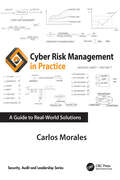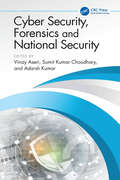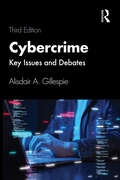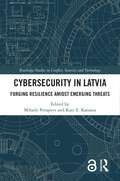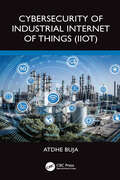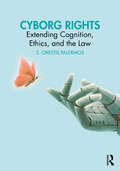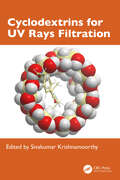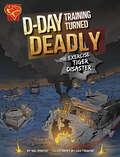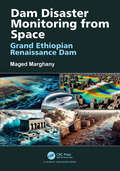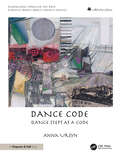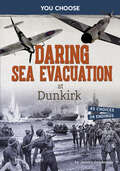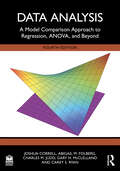- Table View
- List View
Cyber Governance in China: Balancing State Centrism and Collaborative Dynamics
by Cuihong CaiThis book conducts an in-depth investigation into cyber governance in China through Chinese decision-making processes, policy formulation, and international presence, exploring how China navigates governance imperatives while fostering digital innovation in an increasingly interconnected world.The book looks at the governance paradigm of cyberspace in China. It examines the concepts, mechanisms, and practices predominantly spearheaded at the national level by the Chinese government, and the extensive participation of non-governmental entities. It unravels China’s approach to cyber governance, why it diverges from Western approaches, and the causal mechanisms behind these phenomena through empirical research. The book also analyzes the strengths, deficiencies, and consequential impacts of China's cyber governance policies, utilizing social science research methodologies.This will be a book of interest to scholars in international relations, Internet governance, and China studies.
Cyber Risk Management in Practice: A Guide to Real-World Solutions (Security, Audit and Leadership Series)
by Carlos MoralesCyber Risk Management in Practice: A Guide to Real-World Solutions is your companion in the ever-changing landscape of cybersecurity. Whether you're expanding your knowledge or looking to sharpen your existing skills, this book demystifies the complexities of cyber risk management, offering clear, actionable strategies to enhance your organization's security posture. With a focus on real-world solutions, this guide balances practical application with foundational knowledge.Key Features: Foundational Insights: Explore fundamental concepts, frameworks, and required skills that form the backbone of a strong and pragmatic cyber risk management program tailored to your organization’s unique needs. It covers everything from basic principles and threat modeling to developing a security-first culture that drives change within your organization. You’ll also learn how to align cybersecurity practices with business objectives to ensure a solid approach to risk management. Practical Application: Follow a hands-on step-by-step implementation guide through the complete cyber risk management cycle, from business context analysis to developing and implementing effective treatment strategies. This book includes templates, checklists, and practical advice to execute your cyber risk management implementation, making complex processes manageable and straightforward. Real-world scenarios illustrate common pitfalls and effective solutions. Advanced Strategies: Go beyond the basics to achieve cyber resilience. Explore topics like third-party risk management, integrating cybersecurity with business continuity, and managing the risks of emerging technologies like AI and quantum computing. Learn how to build a proactive defense strategy that evolves with emerging threats and keeps your organization secure. “Cyber Risk Management in Practice: A Guide to Real-World Solutions by Carlos Morales serves as a beacon for professionals involved not only in IT or cybersecurity but across executive and operational roles within organizations. This book is an invaluable resource that I highly recommend for its practical insights and clear guidance” – José Antonio Fernández Carbajal. Executive Chairman and CEO of FEMSA
Cyber Security in Business Analytics (Artificial Intelligence, Machine Learning, Data Analytics and Automation for Business Management)
by Hong Lin Gururaj H L B Ramesh Chandrika JThere is a growing need for insights and practical experiences in the evolving field of cyber security for business analytics a need addressed by Cyber Security in Business Analytics. Divided into sections covering cyber security basics, artificial intelligence (AI) methods for threat detection, and practical applications in e-commerce and e-banking, the book's team of experts provides valuable insights into securing business data and improving decision-making processes. It covers topics such as data privacy, threat detection, risk assessment, and ethical considerations, catering to both technical and managerial audiences.• Presents real-case scenarios for enhancing understanding of how cyber security principles are applied in diverse organizational settings• Offers advanced technologies such as artificial intelligence methods for cyber threat detection, offering readers• Provides a detailed exploration of howAI can make cybersecurity better by helping detect threats, unusual activities, and predict potential risks• Focuses on the convergence of cyber security and data-driven decision-making and explores how businesses can leverage analytics while safeguarding sensitive information• Includes insights into cutting-edge techniques in the field, such as detailed explorations of various cyber security tools within the context of business analyticsCyber Security in Business Analytics will be useful for scholars, researchers and professionals of computer science and analytics.
Cyber Security, Forensics and National Security (Advances in Digital Technologies for Smart Applications)
by Adarsh Kumar Vinay Aseri Sumit Kumar ChoudharyThe book serves two very important purposes. One the concept and vulnerabilities due to cyber attacks in all walks of lives are explained along with how to detect and reduce the risk through digital forensics. Secondly, how such threats at a larger proportion puts entire national security on stake. Thus, there are lot of take-aways as the book discusses for the first-time various dimensions of national security, the risks involved due to cyber threats and ultimately the prevention & detection through cyber forensics and cyber security architectures. This book empowers readers with a deep comprehension of the various cyber threats targeting nations, businesses, and individuals, allowing them to recognize and respond to these threats effectively. It provides a comprehensive guide to digital investigation techniques, including evidence collection, analysis, and presentation in a legal context, addressing a vital need for cybersecurity professionals and law enforcement. The book navigates the complex legal and policy considerations surrounding cybercrime and national security, ensuring readers are well-versed in compliance and ethical aspects. The primary purpose of "Cyber Forensics and National Security" is to fill a critical gap in the realm of literature on cybersecurity, digital forensics, and their nexus with national security. The need for this resource arises from the escalating threats posed by cyberattacks, espionage, and digital crimes, which demand a comprehensive understanding of how to investigate, respond to, and prevent such incidents.1) The book consists of content dedicated to national security to maintain law enforcement and investigation agencies. 2) The book will act as a compendium for undertaking the initiatives for research in securing digital data with national security with the involvement of intelligence agencies.3) The book focuses on real-world cases and national security from government agencies, law enforcement, and digital security firms, offering readers valuable insights into practical applications and lessons learned in digital forensics. and innovative methodologies aimed at enhancing the availability of digital forensics and national security tools and techniques.4) The book explores cutting-edge technologies in the field of digital forensics and national security, leveraging computational intelligence for enhanced reliability engineering, sustainable practices, and more.Readers gain insights into the critical role of cyber forensics in national security, helping them appreciate the strategic importance of safeguarding digital assets and infrastructure. For academicians and professional, this book serves as a valuable educational resource, offering instructors a comprehensive text for courses in cybersecurity, digital forensics, and national security studies. "Cyber Forensics and National Security" is a timely and essential resource that equips readers with the knowledge and tools required to confront the evolving challenges of our interconnected, digital world, ultimately contributing to the defence of national interests in cyberspace. This book will also be useful for postgraduate and researchers in identifying recent issues and challenges with cybersecurity and forensics. The academic disciplines where this book will be useful include: computer science and engineering, information technology, electronics and communication, and physics. The titles of courses where this book will be useful (but not limited to) include: Cybersecurity, Forensics, Digital Forensics, Cryptography, Network Security, Secure Computing Technologies , Transferable Machine and Deep learning and many more.
Cybercrime: Key Issues and Debates
by Alisdair A. GillespieNow in its third edition, Cybercrime: Key Issues and Debates provides a valuable overview of this fast-paced and growing area of law. As technology develops and internet-enabled devices become ever more prevalent, new opportunities exist for that technology to be exploited by criminals. One result of this is that cybercrime is increasingly recognised as a distinct branch of criminal law. The book offers readers a thematic and critical overview of cybercrime, introducing the key principles and clearly showing the connections between topics as well as highlighting areas subject to debate.Written with an emphasis on the law in the UK but considering in detail the Council of Europe’s important Convention on Cybercrime, this text also covers the jurisdictional aspects of cybercrime in international law. Themes discussed include crimes against computers, property, offensive content, bullying, sexual offences and cybercrime investigation. This new edition has been brought up to date to include coverage of the latest developments in this fast-moving area, including AI and end-to-end encryption. New chapters dedicated to cyberbullying and cyberstalking and online sexual abuse have also been incorporated.Clear, concise and critical, this book is designed for students studying cybercrime for the first time, enabling them to get to grips with an area of rapid change.
Cybersecurity 2050: Protecting Humanity in a Hyper-Connected World
by Soorena MeratThis book explores the critical intersection of human behavior, cybersecurity, and the transformative potential of quantum technologies. It delves into the vulnerabilities and resilience of human intelligence in the face of cyber threats, examining how cognitive biases, social dynamics, and mental health can be exploited in the digital age.Cybersecurity 2050: Protecting Humanity in a Hyper-Connected World explores the cutting-edge applications of quantum computing in cybersecurity, discussing the efficiency of quantum security algorithms on Earth and over space communications such as those needed to inhabit Mars. The challenges and opportunities of human life on extraterrestrial worlds, such as Mars, will further shape the evolution of human intelligence. The isolated and confined environment of a Martian habitat, coupled with the reliance on advanced technologies for survival, will demand new forms of adaptability, resilience, and social cooperation. The author addresses the imminent revolution in cybersecurity regulations and transforms the attention of the bright minds of businesses and policymakers for the challenges and opportunities of quantum advancements. This book attempts to bridge the gap between social intelligence and cybersecurity, offering a holistic and nuanced understanding of these interconnected domains. Through real-world case studies, the author provides practical insights and strategies for adapting to the evolving technological landscape and building a more secure digital future.This book is intended for futuristic minds, computer engineers, policymakers, or regulatory experts interested in the implications of the revolution of human intelligence on cybersecurity laws and regulations. It will be of interest to cybersecurity professionals and researchers looking for a historic and comprehensive understanding of the evolving landscape, including social intelligence, quantum computing, and algorithm design.
Cybersecurity in Latvia: Forging Resilience amidst Emerging Threats (Routledge Studies in Conflict, Security and Technology)
by Mihails Potapovs Kate E. KanastaDrawing on expertise from professionals, government officials, and academics, this book uncovers the proactive measures taken by Latvia to build resilient cybersecurity capabilities.The work offers a comprehensive exploration of Latvia’s cyber domain, structured around three overarching themes: the ecosystem, its processes, and future perspectives. In doing so, it takes readers through the intricacies of Latvia’s cybersecurity landscape and provides a nuanced understanding of its strengths, challenges, strategic considerations, and broader implications. One of the key contributions of the work lies in its exploration of Latvia’s cybersecurity strategies and resilience. By delving into the nation’s policies, collaborations, and technological advancements, this book uncovers how Latvia has proactively addressed cyber threats, emphasising the importance of tailored approaches for smaller countries in building robust cybersecurity defences. Highlighting the importance of studying cybersecurity in smaller nations, this book stresses Latvia’s contributions to global cybersecurity efforts as an EU and NATO member. The volume advocates for innovation and collaboration, emphasising their crucial role in securing a digital future for nations worldwide.This book will be of much interest to student of cybersecurity, Baltic politics, EU politics, global governance, and International Relations.The Open Access version of this book, available at http://www.taylorfrancis.com, has been made available under a Creative Commons Attribution-Non Commercial-Share Alike (CC-BY-NC-SA) 4.0 license.
Cybersecurity of Industrial Internet of Things (IIoT)
by Atdhe BujaWhile the Industrial Internet of Things (IIoT) continues to redefine industrial infrastructure, the need for thriving Cybersecurity measures has never been more pressing. Cybersecurity of Industrial Internet of Things (IIoT) contends with the critical question of how to secure IIoT systems against the intensifying risks posed by cyber threats and attacks. This book is a fundamental guide for industrial leaders and professionals pursuing to understand and implement effective Cybersecurity solutions. It covers the fundamentals of cyber-physical systems (CPS), Internet of Things (IoT), and IT systems, while handing insights into prevailing and emerging cyber threats targeting industrial environments.This thorough resource connects theory and practice, providing a reasoned theoretical foundation upon practical knowledge. Each chapter builds a vital link between academic research and industry application, making it a valuable tool for both Cybersecurity professionals and industrial practitioners. With a focus on the latest hacking techniques, multidisciplinary standards, and regulatory frameworks, this book prepares readers with the skills and knowledge needed to protect their industrial infrastructure now and into the future.Key Features: Detailed exploration of industrial infrastructure architecture and communication protocols Understanding of traditional security methods and the threats facing IIoT systems Extensive analysis of IIoT vulnerabilities and effective countermeasures Inspection of reference frameworks, standards, and regulatory requirements for industrial cybersecurity Advisement on cybersecurity risk assessment methods and the implementation of protective measures This book is thoughtful for cybersecurity professionals working in cyber-physical systems and critical infrastructure domains, including smart cities, aerospace, manufacturing, etc. It is also a valuable resource for Chief Information Officers (CIOs), industrial engineers, and researchers engaged in industrial engineering. Whether you are a practitioner, a professional, or a student casting to upskill, Cybersecurity of Industrial Internet of Things (IIoT) provides the essential tools and insights to navigate the emerging perspective of industrial cybersecurity.
Cybersecurity, Cybercrimes, and Smart Emerging Technologies: Proceedings of the Second International Conference on Cybersecurity, Cybercrimes, and Smart Emerging Technologies (CCSET 2023), Riyadh, Saudi Arabia, 5th–7th December, 2023 (Conference Proceedings for Cybersecurity and Emerging Technologies)
by Yassine Maleh Abd El-Latif, Ahmed A. Mohammed A ElAffendi Mohamed Ali AlSharaThis book presents cutting-edge research and advancements in the rapidly evolving fields of cybersecurity, cybercrimes, and smart emerging technologies. It serves as a comprehensive reference guide for the latest trends and challenges in securing our digital world.It highlights critical themes such as the application of AI and machine learning in threat detection and automation, the security implications of blockchain and distributed ledger technologies, safeguarding critical infrastructure and the IoT, addressing data privacy and governance, and advancing malware analysis and detection techniques. It also delves into technological breakthroughs in deep learning for fake account detection, blockchain for secure data exchange, DDoS mitigation strategies, and novel approaches to malware analysis. These findings provide valuable insights into current and emerging cyber threats and effective countermeasures.This book is an essential resource for researchers, cybersecurity professionals, policymakers, and anyone seeking to understand the complex landscape of cybersecurity in the digital age.
Cyberterrorism: The Rise of Misinformation and Disinformation
by Ravi DasThe world today is becoming more interconnected than ever before. Because of this, the spread of Misinformation and Disinformation is literally like wildfire, especially with the use of the social media platforms. In this book, we cover this topic in great detail. By focusing on the following: What Misinformation and Disinformation is all about The role of Generative AI in Misinformation and Disinformation The role of Social Engineering in Misinformation and Disinformation The role of Cyberbullying in Misinformation and Disinformation Tools to mitigate Misinformation and Disinformation This will for sure be an explosive topic in the coming years for Cybersecurity.
Cyborg Rights: Extending Cognition, Ethics, and the Law
by S. Orestis PalermosThis book explores the ethical, legal, and rights-related ramifications of the Hypothesis of Extended Cognition and the Extended Mind Thesis. Focusing on technologies designed to extend our cognitive and mental capacities, it highlights serious threats associated with their development and deployment—and examines potential strategies for addressing them.The discussion begins with an accessible introduction to the Hypothesis of Extended Cognition and the Extended Mind Thesis, responding to pressing objections and arguing that humans likely already are—or will soon become—cyborgs. Far from science fiction, the rapid advancement of extension technologies—such as invasive brain–computer interfaces—brings this scenario, and its disruptive consequences across ethics, rights, and the law, ever closer to reality. To underscore the stakes, the book focuses on key concerns relating to mental privacy, mental integrity, and extended forms of assault. It also outlines the values and factors we must consider as we transition into a world where the boundaries of the mind are increasingly fluid. Crucially, it argues that both legal and technological safeguards can be developed to mitigate the most troubling effects of cognitive and mental extension.Cyborg Rights is the first book to offer a systematic analysis of this emerging topic, situated at the intersection of the philosophy of mind and cognitive science, ethics, and philosophy of law.
Cyclodextrins for UV Rays Filtration
by Sivakumar KrishnamoorthyTraditional UVR absorbers pose environmental and health risks due to their volatility, solubility, and toxicity. High concentrations are needed for effective UV filtration, leading to environmental accumulation. Safer alternatives, like cyclodextrin complexation, can enhance UV filtration while reducing absorber concentration. Cyclodextrin complexation offers a promising solution by enhancing UV filtration efficiency while reducing the required concentration of UVR absorbers.Cyclodextrins for UV Rays Filtration addresses a critical gap in photoprotection research by offering a comprehensive exploration of how cyclodextrins enhance UVR filtration. It provides an in-depth understanding of various UVR filters, including organic, inorganic, nanoparticle-based, natural, and herbal filters, while focusing on optimizing their efficiency through cyclodextrin complexation. This book serves as a single-point reference for researchers and professionals, guiding them in selecting suitable cyclodextrins based on UV absorber size, improving SPF/UPF performance, and reducing environmental impact. By presenting both fundamental principles and advanced applications, this book distinguishes itself as the first dedicated monograph on cyclodextrin-based UVR filters, making it an essential resource for academia and industry.Features: Systematic overview of cyclodextrin-based UVR filtration principles, mechanisms, and methods. Insights from experts on advancements and future prospects of cyclodextrin-based UVR filters. Applications of cyclodextrins in sunscreens, lotions, textiles, protective films, and glass. Guidance on selecting and utilizing cyclodextrins for enhanced UVR protection. Coverage of both fundamental concepts and real-world uses of cyclodextrins in UVR filtration. This book serves as a comprehensive and authoritative reference that will significantly benefit researchers, formulators, and professionals aiming to develop safer and more efficient photoprotective materials.
Cyclops vs. Ogre
by A. J. SautterIt’s a battle between two mythical creatures! A cyclops only has one eye, but this monster is also strong and well-armed. Meanwhile an ogre has brute strength and tough skin on its side. Learn more about what makes each of these monsters so powerful. Then decide which one would emerge victorious in a mythical creature showdown.
D-Day Training Turned Deadly
by Nel YomtovOn April 27, 1944, the Allies began Exercise Tiger along the east coast of England. This large-scale dress rehearsal was meant to help landing troops prepare for the upcoming D-Day invasion. Instead, the dry run left hundreds of American military personal dead or missing. What went wrong to turn this training exercise into a deadly disaster, and what was its impact on the war? Young readers will find out in a dramatic graphic novel that tells the tale of one of World War II’s worst military disasters.
DBT Skills Training Manual
by Marsha M. LinehanThe definitive skills training manual embraced by Dialectical Behavior Therapy (DBT) practitioners worldwide is now in a revised edition, reflecting important shifts in language, technology, and daily life. All skills, guidelines, and examples have been retained from the bestselling second edition, with updates throughout to enhance usability and inclusivity. In a convenient 8 1/2" x 11 format, the book provides complete instructions for orienting clients to DBT, structuring group sessions, troubleshooting common problems, and tailoring skills training curricula for different settings and populations. It offers detailed teaching notes for the full range of mindfulness, interpersonal effectiveness, emotion regulation, and distress tolerance skills, and describes how to use the associated handouts and worksheets. Handouts and worksheets are not included in this book; they can be found in the related volume, available separately: DBT Skills Training Handouts and Worksheets, Revised Edition.
DSM in Action: 5th Edition Text Revisions
by Sophia F. DziegielewskiAn updated clinical resource for mental health professionals diagnosing, assessing, and treating mental health disorders in patients In DSM-V-TR In Action, clinician and researcher Sophia F. Dziegielewski delivers an up-to-date and accurate practice resource for mental health professionals applying the DSM-V-TR to diagnose and assess patients. The author introduces the major diagnostic assessment schemes used in the profession and offers comprehensive diagnostic information for each selected category of disorder. The book is packed with hands-on, easy-to-access resources, including explanations of diagnostic criteria, real-world case examples, and a wealth of treatment plans you can apply in your own practice. You'll also find explorations of the most significant changes between the DSM-5 and the DSM-5-TR, as well as: Updated information to match the wording changes implemented in the DSM-5-TR New treatment plans in the Appendix section Contemporary application principles relating to the psychopathologies covered in the DSM-5-TR Perfect for mental health practitioners – like social workers, school counselors, marriage and family therapists, and psychologists – DSM-V-TR is also a must-read for trainees preparing for mental health licensure exams and graduate students studying psychopathology, abnormal psychology, and mental health diagnosis and treatment.
Dam Disaster Monitoring from Space: Grand Ethiopian Renaissance Dam
by Maged MarghanyA groundbreaking synthesis of science, technology, and geopolitics, this book delivers an unprecedented analysis of the Grand Ethiopian Renaissance Dam (GERD). Leveraging advanced quantum computing, radar interferometry, and remote sensing—including Sentinel-1, ICEYE, and TerraSAR-X—this work reveals hidden structural vulnerabilities in GERD and models catastrophic breach scenarios. Featuring the original Marghany Hologram-TomoSAR algorithm and new quantum phase unwrapping methods, it offers critical insights into environmental, engineering, and military dimensions. From sediment saturation to seismic risk, and from biblical prophecy to regional diplomacy, this book challenges conventional narratives and opens new frontiers in monitoring, forecasting, and strategic response to GERD's evolving dynamics.
Dance Code: Dance Steps As A Code
by Anna UrsynMany people relax when coding is introduced as a language, rather than math. Even if someone creates alone, the technology involved in the process has already been developed by somebody else. Even one person's business requires professional input from others, and collaborations are often performed online. This book mixes experiences in art, coding, music, dance, choreography, video, and stage design. Dances have unique structures and so do computer codes. In both disciplines, steps are applied following patterns, and are guided by rules and restrictions. The rules obey conditions. The Dance Code script aims to make coding less feared by readers when talking with coders on the job and typing better prompts when using artificial intelligence. In this book, a dramatized, choreographed story unfolds technical information about coding and dancing.The Dance Code script tells the story of an online interaction between a coder and a prima ballerina, resulting in a shared understanding of their respective fields. An exchange between a coder and a dancer may inspire new ways to look at visually presenting knowledge through dancing, performing, or choreographed movement. Hence, the audience learns without studying.It is a part of the “Knowledge Through the Arts” series, consisting of:Dance Code - Dance Steps as a CodeNew Storytelling - Learning Through MetaphorsCode Appreciation - Reshaping KnowledgeNature Appreciation - Knowledge as Art
Dancing with Roomba: Cracking the Robot Riddle and Building an Icon
by Joseph L. JonesDancing with Roomba tells the unexpected story of the world’s favorite robot. For five decades, corporations spent millions pursuing a floor-cleaning robot. Legions of engineers toiled, dozens of patents were issued, yet every effort failed. Then came Roomba. Selling nearly 50 million units since its launch, Roomba’s unlikely success sprang from a breakthrough at an MIT robotics lab, an inventor who persevered through years of setbacks, and an inspired team that worked as one to smash every problem. This book provides a rare view behind the scenes, revealing how a revolutionary product came to be, how it works, and how a tiny company was able to best a crowd of corporate giants. Written in an easy, narrative style, Dancing with Roomba is accessible to all. Anyone who owns a Roomba, works in technology, dreams of building a product, or is just curious about the robot that launched a million memes will find much to love.
Dangerous Rescue from Amiens Prison
by Matt DoedenMidway through World War II, many French Resistance members were being held prisoner at Amiens Prison in German-occupied France. On February 18, 1944, the Allies conducted Operation Jericho, a daring rescue mission to set them free. Would you rather be an Allied pilot who bombs holes in the prison walls or a free French Resistance fighter who helps whisk escaping prisoners to freedom? Now is your chance to do both—and more! In this interactive adventure, YOU CHOOSE the paths that will lead you and others to freedom . . . or spell your doom!
Dangerous Technologies: Crime and Digital Divides in (South) Africa (Routledge Studies in Anthropology)
by Brandaan HuigenDangerous Technologies focuses on the prevalent theft of consumer electronics in post-Apartheid South Africa. Through a material culture perspective, it explores why these objects have commonly been targeted by bandits and subsequently circulated through the criminal underground. The author traces ethnographically how devices travel between various social spheres, delving into the experiences of a range of individuals: from diverse residents who fall victim to criminals, to the bandits who steal electronics for money or drugs, the African migrants who export consignments of stolen electronics to their home countries, the envious residents who buy stolen electronics, and, finally, the police attempting to grapple with the problem. Dangerous Technologies suggests that electronics have widened digital divides between citizens, resulting in underground circuits that seek to violently redistribute enviable electronics to low-income residents who have not been able to formally participate in electronics consumption and use. Due to porous borders, the widespread theft and redistribution of electronics do not only stem from internal inequalities within South African society but also from broader disparities across the African continent. The book furthers knowledge about how and why particularly modern electronics have precipitated violent property crime in democratic South Africa. It is relevant to scholars of social and cultural anthropology, particularly those with an interest in material culture, digital anthropology, and economic and political anthropology, as well as criminologists.
Daring Sea Evacuation at Dunkirk
by Jessica GundersonYou are taking part in the daring evacuation of stranded soldiers from Dunkirk, in northern France, during World War II. In this interactive adventure, YOU CHOOSE the paths that will lead you and others to freedom or spell your doom!
Data Analysis for Business Students: A Mind-Mapping Approach
by Michael Xin GuoData Analysis for Business Students: A Mind-Mapping Approach is an innovative educational resource that guides business students in mastering the essential concepts and methodologies of data analysis. This textbook's unique instructional design incorporates mind maps, a proven cognitive tool to streamline the learning experience, making complex data analysis concepts more digestible. Organised into five parts, the textbook covers an introduction to data analysis, data preparation and exploratory analysis, basic data analytics techniques, advanced data analytics techniques, and data analysis in a digital world. By integrating mind maps with practical applications and case studies, the textbook equips students with the analytical skills required to succeed in the data-rich business world.This unique pedagogical approach offers three key advantages: Simplifying complex information: Mind maps systematically organise information, making it easier for students to understand complex data analysis concepts. Improving memory retention: By linking pieces of information together, mind maps activate long-term memory and support better memory retention. Increasing student engagement: Mind maps can help students prepare for class activities, enabling a deeper understanding of the subject and allowing instructors to focus more on problem-solving skills and critical thinking. With extensive online resources, including PowerPoint slides, an instructor's manual, a quiz bank, tutorial questions, instructional videos on creating mind maps, and Python code for performing data analysis that students can access, use, and experiment with, Data Analysis for Business Students: A Mind-Mapping Approach offers a structured and accessible approach for advanced undergraduate and postgraduate business students.
Data Analysis: A Model Comparison Approach to Regression, ANOVA, and Beyond
by Charles M. Judd Carey S. Ryan Gary H. McClelland Josh Correll Abigail M. FolbergThis essential textbook provides an integrated treatment of data analysis for the social and behavioral sciences. It covers all the key statistical models in an integrated manner that relies on the comparison of models of data estimated under the rubric of the general linear model.The text describes the foundational logic of the unified model comparison framework. It then shows how this framework can be applied to increasingly complex models including multiple continuous and categorical predictors, as well as product predictors (i.e., interactions and nonlinear effects). The text also describes analyses of data that violate assumptions of independence, homogeneity, and normality. The analysis of nonindependent data is treated in some detail, covering standard repeated measures analysis of variance and providing an integrated introduction to multilevel or hierarchical linear models and logistic regression.Highlights of the fourth edition include: Expanded coverage of generalized linear models and logistic regression in particular A discussion of power and ethical statistical practice as it relates to the replication crisis An expanded collection of online resources such as PowerPoint slides and test bank for instructors, additional exercises and problem sets with answers, new data sets, practice questions, and R code Clear and accessible, this text is intended for advanced undergraduate and graduate level courses in data analysis.

